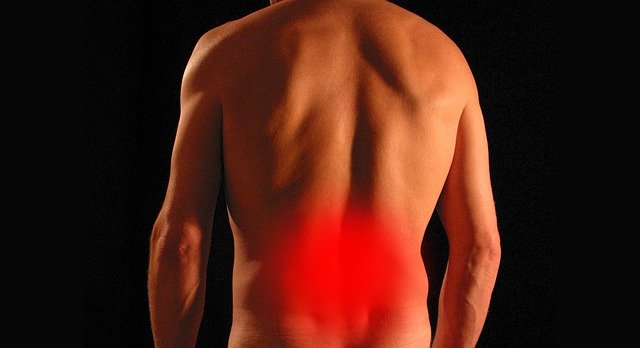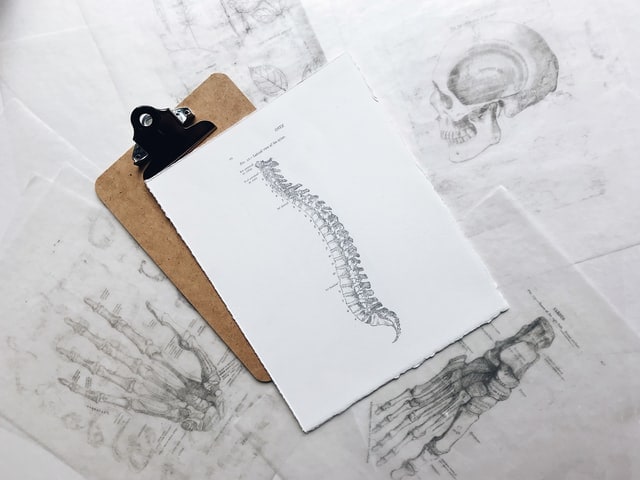Do you wake up in the morning with lower back pain? Do you experience tingling sensations or numbness that runs down the back of your leg? You may be one of the 3.7 million Aussies suffering from chronic back pain. Sciatica is one of the most common causes of chronic lower back or nerve leg pain and it can be extremely difficult or even debilitating for some people.

In this post, we’re going to talk about the causes of sciatica and how you can treat it.
Do you know what sciatica is?
The sciatic nerve is one of the larger nerves of the body, formed from nerve roots that originate in the spinal column. The sciatic nerve controls sensation and function in the legs and feet. The nerve passes between the discs of your spine and extends from the lower back, through the buttocks and down into both feet.
If the sciatic nerve receives pressure at any point on its pathway, it may cause pain. This pressure irritates the nerve and causes pain and stiffness. When the pain spreads to your hips, knee or feet, it is called referred pain. People suffering from sciatica may also feel pain when moving from a standing to a sitting position, sneezing or coughing, or during bowel movements.
Do I need to look for chiropractors near me? What are the benefits of physio vs. chiro and which should I choose? Read on to find out the answers.
What are the causes of sciatica?
Sciatica usually occurs when the nerve is irritated by pressure caused by bulging or ‘slipped’ discs in the spinal cord or by muscles that are too tight or too weak. In rare cases, the pressure could be caused by a bone spur or a tumour pressing on either the nerve or vertebrae.

The most common causes are:
- Tight or inflamed muscles in the glutes
- Degeneration of spinal discs due to age
- Added pressure on the spine due to obesity
- Career hazards like heavy lifting or long hours of sitting
- Nerve damage caused by chronic conditions like diabetes
- Spinal injury or trauma
- Bone spurs or other forms of growth
- Narrowing of the nerve tunnel between discs due to osteoarthritis
- Narrowing of the spinal canal
What are the symptoms of sciatica?
The most common symptoms of sciatica are:
- Pain in the lower spine or at any point along the sciatic nerve pathway
- Pain or spasms in the lower back when coughing or sneezing
- Numbness, tingling or muscle weakness in the foot or leg
- Pain in the muscles of the buttock
- Aches in the hamstring and calf
- Pain in the ankle and foot
- Constant sensation of pins and needles
- Increased pain or stiffness when lifting or straining
- Sudden loss of power and strength in the muscles of the leg and foot
When should I see a doctor?
Do keep in mind that some of the symptoms may be caused by something other than sciatica. If you aren’t sure, it is best to consult your GP. They will be able to tell you if you need to consult a physiotherapist, an exercise physiologist or see an expert for chiropractic alignment.

In most cases of sciatica, the symptoms tend to pass in a few days. If they persist for more than a week, medical care should be considered, particularly if you:
- Experience sudden or severe lower back pain, numbness or muscle weakness.
- Have been involved in an accident that triggered back pain.
- Are noticing changes in bowel or bladder function.
To diagnose sciatica, the expert will take a medical history and examine your spine and legs. The doctor performs a physical examination to assess both muscle strength and reflexes, as well as a series of stretching and movement activities. Medical imaging tests may be required to identify herniated disks or bone spurs.
What is the treatment plan and outlook for sciatica?
Until recently, complete bed rest was recommended for sciatica treatment. However, with new research, it is believed that bed rest may offer only minimal improvement or may even worsen the condition. Sciatica therapies are centred around minimally invasive treatment like physiotherapy or treating symptoms with anti-inflammatory gels, heat treatment or medication.
The choice of sciatica therapies depends on the length of symptoms and severity of your condition. The initial treatments include the following:
- Lifestyle changes
- Pain-relieving or anti-inflammatory medication
- Manipulative therapies such as chiropractic or physiotherapy
Surgery or invasive treatments are only considered as a last resort for extremely severe cases and may include:
- Epidural injections – medication injected directly into the spine
- Chemonucleolysis – Injection of a special enzyme into the disk
Most cases of mild sciatica heal by themselves with time. Conservative treatments which include physical therapies can help expedite the process. When you first experience sciatica, you may be asked to take bed rest for a day or two. However, it is important to return to activity as soon as possible to help your spine stay strong.

In severe cases, treatments like steroid injections (in which pain medication is injected directly into the painful area to help reduce the inflammation) may help. Surgery is only recommended for people who are experiencing significant leg weakness and bowel/ bladder problems. The procedure for sciatica consists of removing the bone spur or some of the herniated disk but may not always totally relieve the pain.
You should see a medical practitioner again if the above measures do not prove to be effective. If your pain lasts longer than a week, is severe or becomes progressively worse. You could consider the following sciatica professionals:
- Your doctor
- Chiropractor
- Osteopathic practitioner
- Physiotherapist
- Acupuncturist
- Surgeon

What self-care measures can I take for sciatica to manage nerve leg pain?
The discomfort of sciatica can be managed at home by the following:
- Rest but not prolonged bed rest
- Prescribed medication like mild painkillers or muscle relaxants
- Ice or heat treatment
- Improving posture through back exercises and stretches
- Avoiding the exertion of bending, flexing or lifting heavy weights
- Warm baths
- Ergonomic mattresses and furniture such as chairs with lumbar support
- Stretching or gentle strength-building exercises to support the lower back
- Keeping weight under check
- Staying hydrated to keep muscles flexible
It is highly recommended to make a habit of these self-care methods to avoid reoccurrence. Staying active is the go-to option for sciatica unless you have been otherwise instructed. Gentle exercises like yoga or swimming have proven to help with pain management.
Physical therapy for sciatica
Physiotherapy or chiropractic care are effective long-term solutions for managing sciatic pain. All the physical therapies involve improving mobility and posture, stabilizing and relaxing muscles, building strength, and reducing pain.
Most physical therapy requires a duration of supervised exercise so that you can learn the correct way to perform movements or exercises. After that, you can add these therapeutic exercises to your routine to help improve pain and ward off future bouts of sciatica.

Self-care and home remedies for sciatica
If you have sciatica, you probably already know a few simple exercises and remedies to help deal with a flare-up. We’ve listed some above but we’ll elaborate on the most effective home remedies for sciatica here.
Get moving
It may sound counterintuitive but moving when you have back pain can dramatically bring down pain. Severe flare-ups may require you to rest for a day but do try to walk about in your house if the pain is milder. When you do not have a flare-up, you should try back exercises at home or make the effort to go for a walk.
Sitting or lying down in one position causes stiffness and inflexibility, both of which are bad for sciatica. When you move, fresh oxygenated blood is pumped to all parts of your body and you’ll feel better very soon.
Hot and cold treatment
Cold treatment is a great way to reduce stiffness and inflammation if used in the early stages of any muscular pain. Place an ice pack in your refrigerator at all times so you always have one on hand. When you feel the pain coming on, use the ice pack for 20 minutes at a time and give your body time to warm up for 20 minutes in between.
Heat treatment is another way to relieve pain from sciatica. Use a heating pad or a hot water bottle against your lower back for at least 20 minutes. If you are using an electric heating pad, remember to unplug it before you fall asleep.
Consult a physiotherapist or exercise physiologist
This home remedy for sciatica depends on the cause of your pain. You might be in pain because your muscles are either too short, too tight, overly stretched, or too weak to support your body.
In some cases, you may need a physiotherapy massage to reduce tension in the deep muscles of your body. This can provide instant relief and allow you to regain some mobility.

An exercise physiologist or physiotherapist will also be able to create a series of exercises or postures that can address the problem and reduce your pain.
If you have a prescribed course of exercise to do, you should make sure you stick to your schedule. You may also like to try some gentle stretching to help ease the aches and pains of a sedentary life.
Check your home and office furniture
If you wake up with lower back pain, it might be caused by a lumpy mattress or a pillow that affects your posture. If you spend hours slouched on your sofa or at your office desk, you might feel pain at the end of the day.
Apart from being aware of your posture, you should examine your mattress, your pillow, your sofa, and your office chair and desk. Having the right support and choosing ergonomic furniture can go a long way in reducing most types of back pain.
If you sleep on your side, it may help to place a firm pillow between your knees. If you sleep on your back, it may help to place it under your knees.
Try yoga
Trying yoga for back pain means that you can choose from hundreds of poses designed to stimulate your inner organs, boost mental peace, promote bodily functions like digestion and elimination, and reduce pain.
Do note that you should let the yoga teacher know you’re looking specifically for relief from sciatica. This will enable them to design a series of moves to help strengthen the core and improve flexibility in the hips and lower back.
Watch your movement
If you try to lift something heavy with the wrong posture for standing or bending, you are likely to cause a spasm or sciatic pain in your muscles. When you lift something, your body uses the strength of your core, your lower back and your glutes and thighs. Incorrect posture can distribute the weight badly or cause one part of your body to bear more load than it should.
By learning the right postures for lifting and bending, you can avoid triggering lower back pain.

Remember that the effective reduction of your symptoms depends on the origin, history, diagnosis and professionally guided course of action for your specific condition. The biggest deciding factor when it comes to the speed of your sciatica recovery is YOU. You can increase the pace of recovery by maintaining regular physical activity and following the treatment plan that is tailored to your requirements.
If you would like to consult a physiotherapist or chiropractor for back pain, Avaana can help you find one near you.



